
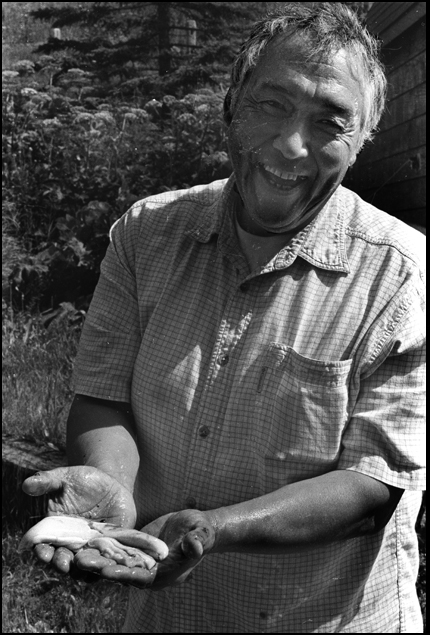 |
| Fred holding the sperm glands of a gutted red salmon |
 | ||
| 77 salmon were caught after an evening of dipnet fishing that is only allowed for natives. |

Fred The Whale Hunter
Fred was a shaman? So I'm told.
I do know that he was an Anupiat whale hunter with a fridge full of blubber. He would sit in the gift shop in the Ninilchik village run by his friend Laura and tie fishing flies that had googley eyes and were made with polar bear hair. He claimed that the polar bear hair was his secret weapon because it is actually not white but translucent and hollow. This means that it catches light easier and sparkles for the fish. I never saw this assertion proven to me but I learned quickly not to question Fred.
My friend Regina introduced me to him one day at the gift shop. He got directly in my face with a big smile and said, "You want to go fishing?!" I felt cornered by his friendliness and responded, "Yes." He said, "Good answer." He quickly walked away. His affirmation was because of his obvious enthusiasm for fishing. But it was also as if I stumbled upon an Eskimo gatekeeper who I responded to correctly and with detached authoritative approval was allowed entrance. Had I hesitated I would have been shunned.
He was a raw arctic blend of apparent innocence and willful conquest, like a seal that swims ashore to occasionally hunt caribou. I had heard that he was a legal counselor of sorts to other Native-Americans in the area. I believe this is due to the fact that he successfully fought the Federal Government three times in cases that each lasted around 10 years. My rough understanding is that one case dealt with their keeping or maintaining the rights to their land, another dealt with their right to harvest polar bears, and I don't know what the other case was about.
Since he stayed mainly at the gift shop in the original Ninilchik fishing village he dealt with tourists often. The tourists would stream in during the summer, mostly from the "Lower 48", and many would want to start a conversation with the eskimo and have a cultural experience. Fred played around with this a lot, like Mickey Mouse holding a delicious disney-made pie that the tourists would want a piece of. He would playfully wave at their obvious curiousity and give his usual loud "Hiiiiii!!" and if they wanted to know what he thought he would throw the pie in their face and tell them to piss off, explaining with barely subdued belligerence why their people are morans.
He wasn't always like that though, he would sit in the gift shop and chat up anybody who wanted to talk. While I was there he actually ended up meeting a photography teacher from the University of Louisville where I am from. He told her about me and how I was up there taking photos. I didn't meet her while she was there but I messaged her and she got me in her art photo class later on. The coincidence amazed me. I mentioned Fred when I got into her class and her eyes widened with a mixture of benign fear and humor saying, "Yea, that guy will screw anything that moves."
Direct is a good word for Fred. He taught me to bash fish directly in the head with a stick after bringing them on the boat. He would walk directly up to women and say "You have a nice butt!" or directly up to a Fish and Game representative, put his arm around their shoulder and say "How about you guys cut down on the charter boats!", all with an aggressively happy smile that focused directly on you like an Eskimo friendship laser.
There were several instances that reminded me to consider the fact that when he wasn't in Ninilchik he was in "The Village". This was where his people lived, the Anupiats. They are a whale hunting community. When they bring in the whale the whole village shares it. "The Village" was somewhere deep in the depths of Alaska on the Tundra where the highways don't reach. You can't grow food out there so they have to subsist off of hunting, using things like seal oil for a wide variety of purposes. I'm told they are notorious for their treatment of the women. All in all it doesn't seem like the kind of environment that nurtures much sympathy in a person. I kept that in mind after I saw Fred accidentally run over a dog while coming home. He said, "If we were in the village we would just shoot it."
Regina told me that he was a shaman. I was intrigued. I got to go fishing with him on several occasions and one day when he was driving us to the Seward Silver Salmon Derby, where we caught nothing, I asked him if he was a shaman. He looked over at me and laughing from his gut said "Noooooo! Ha Ha Ha". But he finished his jovial denial glancing out of the corners of his eyes like someone concealing a secret thinking, "hmm."
There are strange stories that are connected to the notion of him being a shaman. I am not fully aware of the details and I mention it without any amount of certainty but there supposedly was a little black bag that an elder in his village had brought back from africa that contained a rock. This rock was powerful. His elder died and the rock was given to Fred. Regina said at one point that Fred and Laura asked to stay at their house on an intensely snowy night but Regina said no because she was taking care of her mother who had alzheimer's. As some form of revenge for this injustice Fred buried the rock in her driveway and around the same period of time a tree fell on Regina's hand and broke it, nearly crushing it.
They said that anyone who possessed this rock ended up dying suddenly. Fred died in the early spring after I visited. Supposedly he was just getting ready to go fishing and had a stroke. He was in his mid 50s. There was another man who had possession of this rock after Fred and he was found dead with a shotgun next to him in a shed in what appeared to be a suicide. I had been told that the rock was buried with him so that no one else would have it but it is suspected that someone may have killed him for the rock. It was also suggested that foul play may have been involved in Fred's death.
Fred enjoyed listening to Coast to Coast Am. He said, "This guy knows what he's talking about", Looking up wide-eyed from his plate of halibut while they discussed UFO encounters on the radio. He enjoyed pulling the car over at night to look at the rich Alaskan night sky. He was well-known in the region with people always dropping by to go fishing with him..He liked country music, smoking pot, berating people who were not doing what they were supposed to do on his boat, and I never saw him catch a fish using a pole on any of the trips where that was the option. I however did catch a halibut using the pole. He was my fishing buddy that summer and I'll always appreciate his generosity in bringing me along.
At some point during the next spring when he died I was sleeping in my Mom's house in Kentucky and I had a dream that I was with Fred on his boat. We were on what looked like a river winding through rolling Kentucky hills at night. He turned around to me got directly in my face as usual and said, "We gotta get you back to your Mom!"

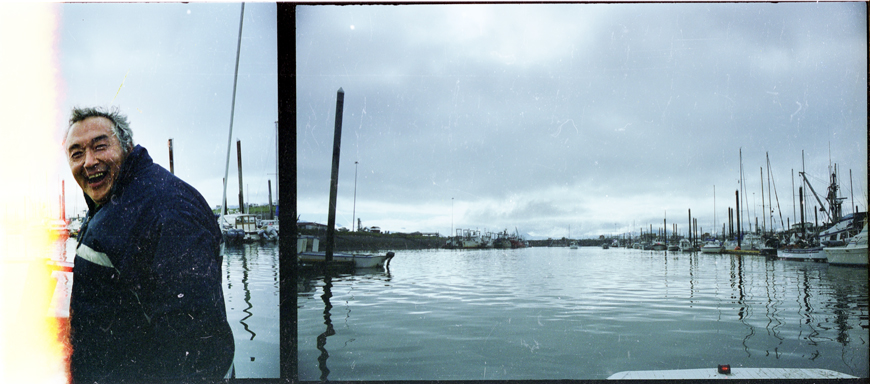







Set-net Fishing
Just up the coast about a quarter mile from the Ninilchik village is the Deiman's fishing site. It lays just out of the waters reach between the beach and the bluff. The tide changes 4 times a day at the foot of this small collection of stove-heated shacks like liquid clockwork. The sun slides at a shallow angle at midnight during the summer's peak behind a horizon of mountains and volcanoes only to return 2 hours later. The waves are always churning in varying rhythms and the wind from the Inlet rushes up the bluff's wall in a streaming cushion of air that the bald eagles glide along. When the tide recedes the beach expands far downwards to a wide flat surface where the tourists, wearing black garbage bags to stay clean, skitter like birds looking for worms, digging up the razor clams left from the water's presence. When the tide returns it swallows the enormous gap it left and returns to the fishing site's edge with the pulsating sound of a static television.
Every summer from mid June to mid August, when the red salmon run, they set their plan into motion. They are one of the most southern set-net spots along the Kenai peninsula which means that they get first dibs at the salmon heading north along the coastline back to their native rivers. The fishing site serves as their headquarters and safe-haven for tending the nets, which they fasten in a strategically placed corridor of buoys within .5 miles of the coast. This is set-net fishing. The drift-netters, who drag their nets behind their boats, do their work past the .5 mile mark.
Gary Deiman (top left family photo) was the boss for 3 of the boats which were run by himself and his 2 daughters, both teenagers at the time. A family member Tim ran a boat of his own and a man who I believe was father and grandfather to many of them (bottom right photo) ran the other boat with his grandson Dustin.
The rest of the crew consisted of; Gino, a 15 year old cousin from Minnesota, who carried himself as an eager fisherman's apprentice, listened to christian music, and stopped having problems with his asthma once he got to Alaska; Paul, a neighbor and former gold miner who frequently works with them and wears a small nugget of gold on his necklace; a lanky young kid with blue streaks in his hair; Tim's friend whose mullet declared his ability to knock back beers and laugh with an esophagal hiss; and myself, just lucky to be working with them.
The site is made of two main cabins with a wood stove, kitchen, table and bunks in each, and a couple of smaller shacks, with bunks and a wood stove. There is an outhouse, no running water, a smokehouse, a few pairs of wooden rails to hang and work on the 220 ft. nets, and 3 very old boom trucks which they use to lift and transport the 20 ft. aluminum boats to and from the water's edge. I'm not sure how long they've been fishing at this site but it clearly is a tradition and endeavor that binds the generations of the family together along with friends in the area who work with them.
The routine was unpredictable except in it's goal, to catch salmon. Fish and Game dictates through recorded message updates over the phone whether fishing is allowed based on the amount of fish coming up the rivers. Once a quota is met in the rivers they open up commercial fishing on a strict time schedule. The fines are severe for having a net in the water even minutes before or after the time limit. If fish and Game says that set-net fishing is open from 5am Monday to 7pm Thursday then the fishermen focus intensely on using this time as effectively as possible, getting 2 or 3 hours of sleep here and there. How they use this time depends on the temperament of the water and the fluctuating of the tides. It can be difficult and dangerous to try to enter the water or return to the beach with rough water and white-capped waves and the proportions of ebbing and flooding tides are an indicator of odds, with an incoming tide most likely to bring the fish with it.
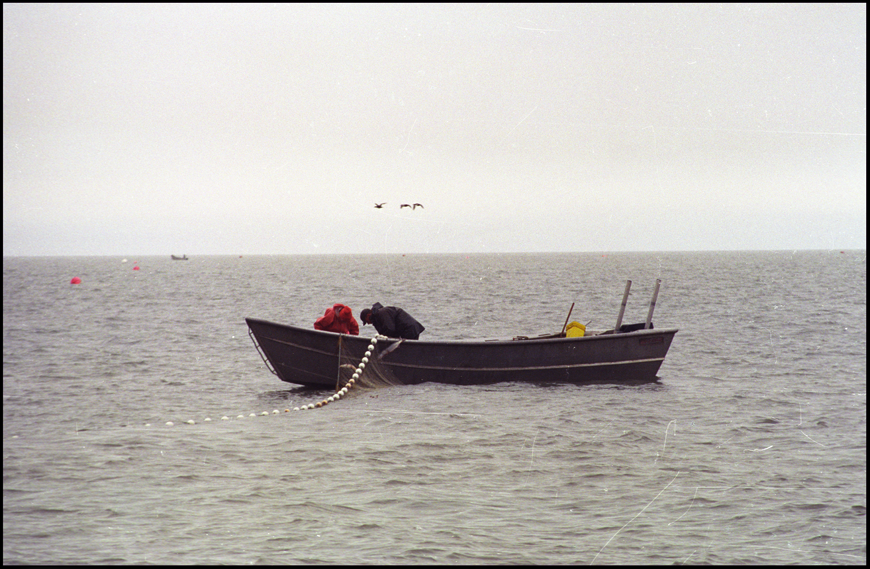
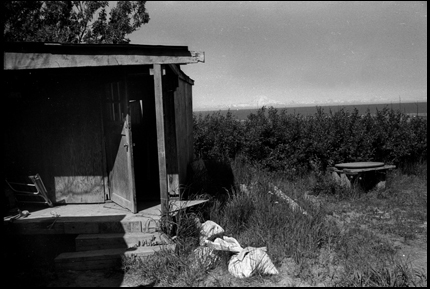
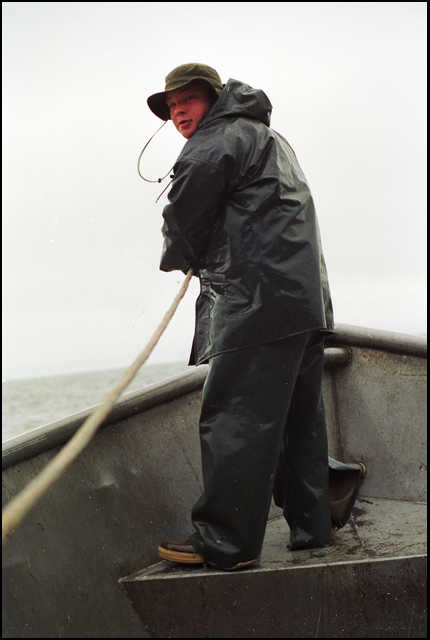
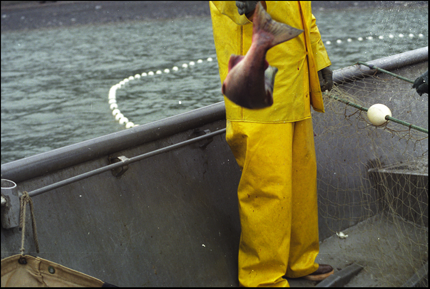
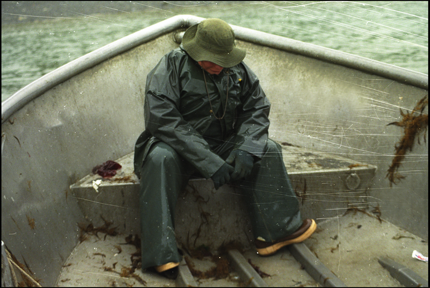

When everyone got word that fishing was going to be open we all congregated at the fishing site and got ready. The shack that I stayed in included Gino, the lanky blue haired kid, and myself. Whenever it was time for us to get up our alarm clock Gary opened the door and shouted "Aaaaayyyy Ginoooooooo!!!" This was often at 3 or 5 in the morning depending on what type of fishing schedule we were working with.
We would stagger out in an early morning daze and head to Gary's cabin where everyone in his crew was sitting at the picnic table inside, about 7 or 8 of us. Gary's wife Sharon would pile food in the middle of table; moose sausage with french toast and eggs or if it was lunch time it was moose burgers or some other variation of moose. Gary would check the tide book which contained the measurements of the expected ebbs and floods and we would put on our boots and rain gear; waterproof overalls and a jacket with a hood which were always either green, yellow, or orange.
The boats were already prepared by this point. In the off moments everyone tended to the gill-nets and checked them for holes as they laid draped over the wooden rails. If there were any holes from ripping fish out or from seals or other debris then we mended them. They were 220 ft. wide rectangles containing a grid of something similar to fishing line with corks lining the top, leads lining the bottom, and ropes on the ends to tie them to buoys using a buoy knot. Once the nets were checked and ready they were each coiled into two piles inside the boat. The corks were coiled and the leads were coiled next to them. This was because after connecting one end of the net to a buoy they would drive the boat to the other buoy as the corks and leads seperately unraveled rapidly percussing the edge of the boat like a tightening ratchet. Most boats were in charge of 3 or 4 nets.
The boats were lifted off the ground by boom trucks and carried to the water's edge with one or two people walking beside the boat to steady it's swinging. At the water's edge was a rope connected between the beach and a buoy that we would use to pull the boat out to a depth safe enough to lower the engine and head to our respective buoys. The engines would rev and the boats would skim on top of the waves ramping off and slamming into the water with steady wet thuds while we held on to the side of the boat and let our legs bend with and absorb the shock.
We connected the nets and began checking them over and over. We would pull up to the net and the "Bow Monkey" would reach over the front of the boat to grab a hold of the cork line and pull up the net beneath it, with their feet dangling as their bodies bent into a V and their midsections braced them on the rim of the boat. The net would then rest on top of the boat crossing its sides and we would pull along the net from end to end as the contents clumsily spilled into the boat.
The contents were mainly seaweed, jellyfish, flounders, sand sharks, garbage, and on a good day tons of salmon. Everything had to be picked out. The gloves we used were cloth and always wet of course. The nets are made to wrap around the fish's gills so you would have to reach deep under the fishes gills to pull out the taut, thin net, leaving your hands in a wrinkled and very sore state by the end of the day. The fish were thrown into brailer bags which usually safely filled to just under 1000 lbs. When the bag was full it was lifted from the boat by a crane on a tender boat which waited at the .5 mile mark and the weight was recorded.
Most of the time the sea was relatively calm. At "slack tide", the moment when the tide changes directions, it was even placid. But one day we had to fish with 4 ft. rolling waves. The sea's surface was a steady barrage of liquid hills and valleys which you would ascend and descend while trying to work. The strength of the water's current forced the nets into their tightest state like an open parachute. To bring the net in was a significant challenge and required us to first grab a hold of the cork line and hang on tight as the waves lifted the boat, the net and your stretched clinging arms. As the waves descended that was the time to grab as much of the net as you could and then get someone to help you get it over the boat's edge quickly before the waves rose again. The boat was then pinned under the tight net and above the turbulent water.
One lucky person would crawl under the net and position themselves in the small triangle created by the bow of the boat and the intersecting net. They would pull or pick fish within this small tense space between a net gripping the sides of the boat with the same force as the waves sending you up and down an aquatic rollercoaster. It is uniquely humbling to try to operate along in your own fashion in defiance of the moon's temperamental grip on your planet's tides.
But on the shore I would often walk down the beach and climb up the bluff to watch the sunset and this led to one of my favorite moments. The sun was going down diagonally behind a volcano on the horizon at midnight as I sat right under the point where the eagles soar along the bluff. A flock of seagulls scattered from the beach in the golden light. Two eagles then flew 5 feet above my head with the second looking at me with a "Caw". Then the single engine plane, parked on the beach which was visiting the Deiman's site, revved it's propeller, turned itself facing north and flew above the water's edge at my eye level tipping it's wings to say "hello".
